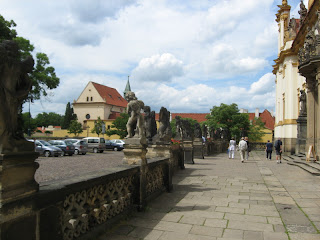 From June 9 to 11, the General Definitory met with the members of the Capuchin Conference of Central and Eastern Europe (CECOC). The meeting took place in the beautiful city of Prague, in the Czech Republic.
From June 9 to 11, the General Definitory met with the members of the Capuchin Conference of Central and Eastern Europe (CECOC). The meeting took place in the beautiful city of Prague, in the Czech Republic.In contrast to the situations in CIMPCap and CIC, with whom we met immediately prior to this meeting, it is difficult find a synoptic way to characterize the Conference since the situations in its various jurisdictions vary greatly. For instance, some jurisdictions have many vocations while others have very few. The pace of societal change is also different from country to country. Nonetheless, it is possible to find a few common elements that link many, if not all of the Conference's jurisdictions.
First, many of the jurisdictions share a history of suppression and oppression, having lived under more or less hostile Communist regimes. Many of these regimes maintained control by effectively using its citizens to spy on one another, which bred a certain form of innate mistrust among members of the society that has not completely disappeared. As a result, the basic sense of trust that is so important to fraternal relationships is difficult to establish. The problem often manifests itself in the inability to live serenely in a community or to accept authority.
The crumbling of the Communist regimes across central and eastern Europe allowed the Capuchin Order to operate freely and openly, but it also brought with it a new set of challenges. While many rejoiced in their new-found liberty, that liberty was not slow to degenerate in license. Thus, many jurisdictions that experienced a burst of vocations in the immediate aftermath of freedom, are now seeing vocations fall as young people become more materialistic and disinterested in the Church. In addition, the young men who ask to join the Order come with widely varying degrees of faith background, which creates an additional challenge for the jurisdictions' formation personnel.
Another result of the fall of Communism was the restitution of many of the friaries that had been taken away from the religious congregations. This was only right and just, but it has also been a mixed blessing. Some jurisdictions now find themselves saddled with structures that are much larger than present needs dictate, and which are financially difficult to maintain. This, at least, is one issue that they have in common with the Capuchins in the rest of Europe. The challenge everywhere is to find the correct balance between the preservation of meaningful connections with our past and the wise use of our limited financial resources.
I would be remiss if I did not say a word about the excellent hospitality of our Czech hosts. The meeting was held at the recently-restored friary adjacent to the Loreto Shrine in Prague, which was the first friary to be given back to the Capuchins of that jurisdiction. The picture above was taken from the front of the Loreto Shrine with the friary in the background. It is a beautiful friary in a beautiful city. [In the interest of full disclosure: my great grandparents emigrated from Moravia, then part of the Austrian Empire. If you wish to split hairs, Prague is in Bohemia, but that is close enough for me.]
P.S. Someone suggested that the building pictured below may have been at one time used as a novitiate (enlarge the photo by clicking on it, then find the clues for this assertion).

No comments:
Post a Comment